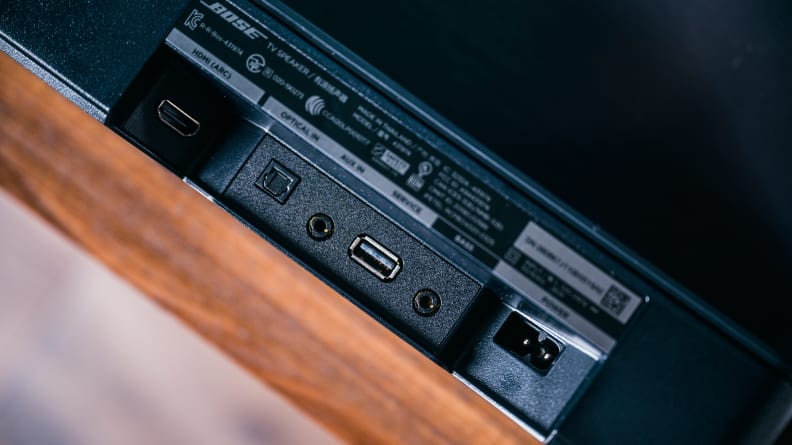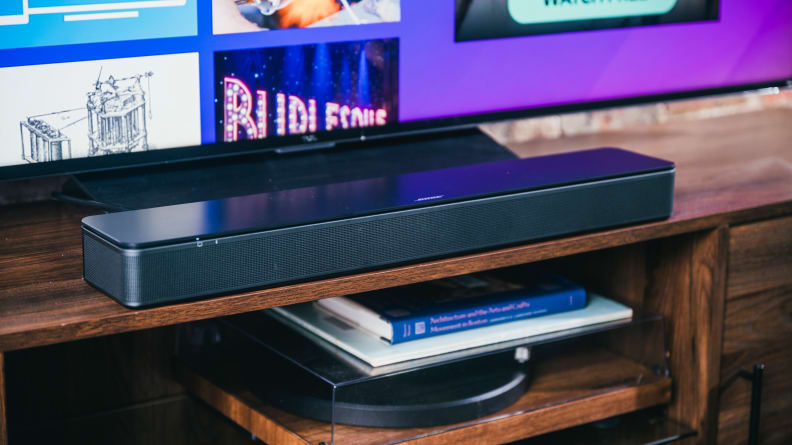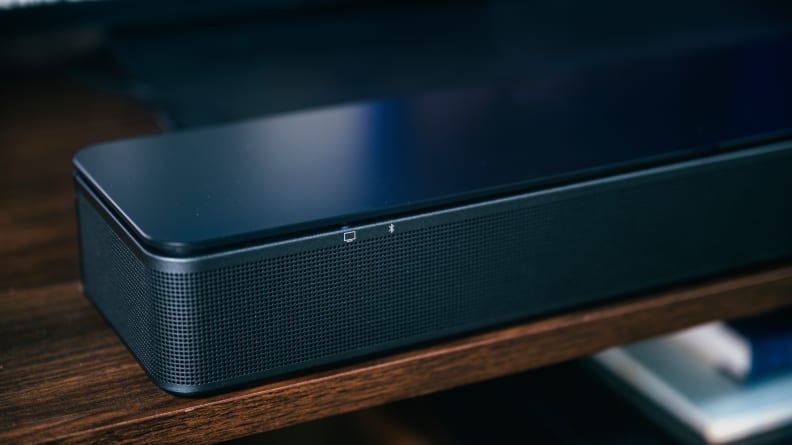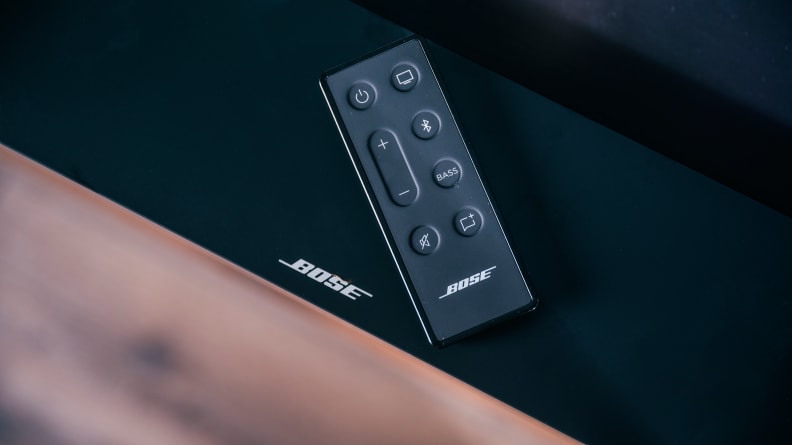Pros
-
Easy to set up
-
Dialogue mode great for podcasts
-
Clear, sweet sound
Cons
-
Lack of features
-
No included subwoofer
-
No virtual surround sound
About the Bose TV Speaker
Here’s a look at the soundbar’s main specs:
- Height x Width x Depth: 2.2 x 23.4 x 4 inches
- Speakers/channels: three channels, including left, center, right
- Wireless connection: Bluetooth 4.2
- Wired connection: HDMI ARC, Optical, AUX
- Smart features: None
- Sound formats: Dolby Digital, PCM
- Video support: N/A
- Colors: Bose Black
- Optional upgrades: Compatible with Bose Bass Module 500 and 700
Bose is one of the biggest names in home audio, and the TV Speaker is a prime example of that experience coming to bear. It trims out all the fat and targets those looking for easy setup and a fast upgrade. The bar sounds good and can get quite loud for its modest size, delivering an audio enhancement that is immediately apparent. It adds utility by easily connecting to smartphones and tablets to play music, stream audiobooks, or listen to podcasts via Bluetooth. If you do enjoy spoken word content, the speaker features an alternate Dialogue Mode which brings voices forward and increases their clarity.
That ease and simplicity comes at a cost. The TV Speaker doesn’t offer the same level of customization as competing options, like the Sony HT-S350 or even Vizio’s cheaper V21-H8. There’s only a single alternative sound mode for dialogue and tone control is limited to bass only, which makes it a one-size-fits-all option otherwise. There’s also no subwoofer, so while it can get loud and sound good doing it, it doesn’t have the same cinematic chops as some of the competing soundbars in our Best Soundbars Under $300 list.
What We Like
Setup is fast and painless (and using it is even easier)

Simplified I/O with simplified setup makes the TV Speaker a great choice for users leery of new tech.
Connecting the TV Speaker to your television is fast and easy, so even users who dread technology should be in good shape. The device supports audio over HDMI ARC, Optical, and analog connections and each is as simple as plugging a single cable from the soundbar into the matching port on your television.
Depending on the model of your TV, you may need to disable sound from its built-in speakers or enable HDMI ARC. On my TCL 6-Series, I was able to do both of these with a single trip to my TV’s menu. The only downside is that Bose only includes an optical cable in the box, so if you need to connect over HDMI (or with an aux cable), you’ll need to bring your own. Connecting over HDMI ARC is preferred if available, as it allows you to use your TV remote for power and volume control.
Once it’s set up, using the TV Speaker is as intuitive as can be. The soundbar is controlled with an included remote with buttons for volume, mute, bass, and power, Bluetooth and Television inputs, and Dialogue Mode (there are no physical buttons on the soundbar itself).
The simplicity of its design is intuitive and easy to learn, even if it’s your first soundbar. Depending on what’s being watched, you may want more or less bass, but I found that once I had it dialed in, it rarely needed to be adjusted, leaving only volume and mute for sound controls. There’s also a useful Auto-wake mode that can be enabled by holding the power button for five seconds, allowing it to power on along with your TV.
Dialogue Mode is the only alternate sound mode offered by the TV Speaker. Like the rest of the unit, it’s simple and straightforward. Pressing this button raises the mids and brings voices to the forefront with enhanced clarity. It’s a great choice for podcasts, YouTube videos, audiobooks, and other forms of spoken word content. This mode is especially useful when completing chores in a neighboring room. The added crispness allows words to cut through household noise and still be heard clearly.
Like nearly all soundbars, the TV Speaker also supports Bluetooth connection for wireless audio. This is great for streaming music from your phone but is slightly more complicated to set up. Holding the Bluetooth button on the remote puts the soundbar into pairing mode and can then be selected from the Bluetooth menu on your device. From there, anytime the Bluetooth button on the remote is pressed, it will automatically reconnect to the paired device.
It’s a big upgrade from built-in speakers

Just as big as it needs to be, the soundbar embraces minimalist chic.
Bose has a reputation for delivering excellent sound quality in its products and that’s definitely the case here. The TV Speaker uses a three-channel speaker arrangement (two stereo speakers and a center channel) and is able to produce rich, detailed sound for the price point across all types of content.
The speakers are forward-facing, so they don’t produce the same sense of scale as the upward-firing speakers you’ll find in Dolby Atmos soundbars. That said, the dynamic range is excellent. Even at low volumes, I was able to hear every piece of dialogue and atmospheric detail in Disney Channel’s Loki when my TV’s built-in speakers would leave me riding the volume button between scenes. The omission of a subwoofer, built-in or external, means the TV Speaker lacks the punch and rumble of 2.1 channel soundbars, but it’s still a big upgrade from your TV alone.
The musicality of the full-range speakers really begins to shine when presented with music streamed over the bar's Bluetooth connection. Again, you won’t find pounding bass, but the TV Speaker was able to fill out the low-end enough to keep songs sounding full. Vocals especially sound sweet, full of detail and texture, which isn’t a surprise since the soundbar uses the same cinema-centric equalizer preset across all of its inputs.
It fades into your home theater setup
The TV Speaker isn’t out to steal your attention. It’s made to slot into an existing entertainment setup and to elevate the experience without getting in the way. The simple black exterior and small size allow it to fade into an existing setup without becoming distracting. Bose even sells an accessory wall mount to ensure it can be positioned as seamlessly as possible.
The lack of cabling compared to a larger home theater setup, or even another soundbar with satellite speakers, keeps your entertainment area looking clean with minimal effort.
What We Don’t Like
It’s simplified to a fault

Simple white LEDs indicate bass and volume control.
The TV Speaker is made to be simple. That’s an asset to many users, but at $249, Bose may have trimmed a little bit too much fat from this device. With the exception of bass adjustment and Dialogue Mode, you’re limited to the stock sound signature, regardless of what type of content you may be enjoying. That means if you prefer a different sound for listening to music over Bluetooth versus watching an action movie on Netflix, you’re out of luck.
Compared to competing soundbars like the Vizio V-Series 2.1, the TV Speaker feels one-note. Vizio’s option includes multiple content-based sound modes, virtual surround sound, an equalizer, and an external subwoofer for a fair bit less cash. The V-Series 2.1 is exceptionally full-featured for its price, and the TV Speaker isn’t terribly far off from the bulk of its competition overall, but it’s clear that Bose isn’t trying to deliver a full sound system with this one device.
I also missed having physical buttons on the soundbar itself. Without app support, a remote control is the only way to control the unit if you’d care to use the optical or analog connections. When connected over HDMI ARC, you’ll be able to use your TV’s remote to control volume and power. Likewise, the TV Speaker can be controlled with a universal remote, so you won’t be stuck reaching out to Bose for a replacement remote should the included remote get lost.
It doesn’t offer a great cinematic experience

The remote is small and simple but potentially easy to lose.
The TV Speaker is an absolute upgrade from the built-in speakers that come on most TVs but it doesn’t have the cinematic prowess to turn your living room into a home theater all on its own. The lack of a subwoofer limits the amount of low-end it’s able to produce, and while it can certainly sound full, this isn’t a device that will be rumbling your floors anytime soon.
If you’d like to add more bass, you’ll need to purchase an external subwoofer. Connecting it should be easy thanks to a single jack in the back of the bar, but that doesn’t mean it will be cheap. Bose says the TV Speaker is compatible with its Bass Module 500 and Bass Module 700 units which retail for $399 and $699 respectively.
Gamers might also find the TV Speaker lacking in its sense of space. Without upward-firing speakers, or any sort of virtual surround, there’s little verticality to the sound. Call of Duty: Warzone was still perfectly playable for a scrub like me, but competitive gamers will still find themselves reaching for a gaming headset for its improved positionality.
You might be stuck buying extra cables
As a speaker designed for ease of setup and operation, it only includes optical and power cables in the box. The optical cable will work for most modern TVs, but if you’d rather connect over HDMI ARC or the auxiliary (3.5mm) connection, you’ll need to bring your own. That might mean a frustrating trip to the store between unboxing and actually enjoying your new product. (Or you can order an HDMI cable directly ahead of time.) The TV Speaker may be Bose’s entry-level soundbar, but it misses the mark in not providing everything users might need out of the box.
Should You Buy It?
Yes, but only if you need exceptional simplicity
The Bose TV Speaker is a fast and easy way to enhance your TV viewing experience. The listening experience is good, but it’s the ease of use that really makes this a compelling option. Within minutes, it can be dropped into an existing TV setup and sounding great, assuming you have an optical connection or the other required cables. With only volume, bass, and Dialogue Mode to choose from, it’s simple to operate, making it a particularly good choice for users who may not be tech-savvy.
That said, at $249 it’s still an expensive option for what’s actually being delivered. The lack of a subwoofer limits the amount of bass it’s able to produce and the types of cinematic experiences it can create. Likewise, there’s no form of virtual surround sound to add depth to movies and games, or additional sound modes for music or sports. Under $300, we expect some limitations but the simplified nature of the TV Speaker stands out.

The iconic Bose logo offers a touch of flair at the top of the TV Speaker.
If you don’t need things quite so simple and also want to save a few dollars, the Vizio V-Series 2.1 is an excellent alternative. It adds each of the missing features listed above and adds Wi-Fi streaming on top for under $200.
Alternatively, if you like the simplicity of the TV Speaker but want some added performance oomph, the Klipsch Cinema 400 puts sound quality above all else for only $299. Bose’s own subwoofer, the Bass Module 500, sells separately for $399.
If you don’t mind its limited feature set for the money, the Bose TV Speaker remains a solid option. Its fast setup, ease of use, and great sound quality make it a compelling option for users who want to spend less time learning technology and more time enjoying their content, even if they’ll pay slightly more to do so.
Meet the tester
Chris has been specializing in PC and audio-related tech since 2015. Find him at IGN, Tom's Hardware, PC Perspective, MMORPG.com, and more.
Checking our work.
Our team is here to help you buy the best stuff and love what you own. Our writers, editors, and experts obsess over the products we cover to make sure you're confident and satisfied. Have a different opinion about something we recommend? Email us and we'll compare notes.
Shoot us an email



